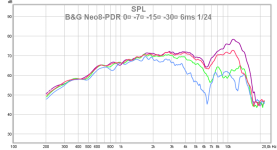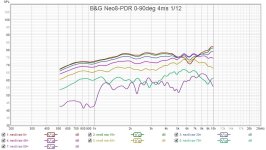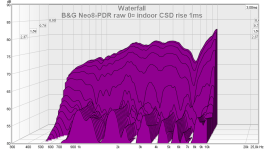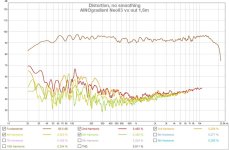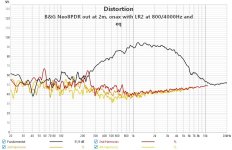It's possible one of his workmates ended up with everything needed to build a top tier turntable using such methods. It's possible he didn't.Well, some extra terrestrial in his home should have a stereo system; maybe kill two birds by making your speakers be a part of the movie set and when they're done filming...
I thought I already shared but apparently not I can't see it, if I can old pics I’ll do or update a thread, thx for the interest 😉
Please share how you supported drivers baffle-less and iterated quickly. (Followed your U-frame thread.) Thanks.
Trung is right that response is better on one side on offset driver baffle than the other, except got the sides reversed. Edge diffraction makes wave emit backwards where the original sound came from. Thus better response is on the opposite side to close edge, because from driver to edge and back is shorter distance than on the other side the delay is less and bandwidth of interference is higher up in frequency, perhaps out of band if very close to edge. Can be imagined, but is not just imagination, you could check it with simulator and take what you wanna.
edit. There is actually a listening test for edge diffraction audibility hidden: Take a speaker with offset drivers, and listen from say 45 deg angle. Which side sounds better, when the offset driver is closer to you or when its farther? Repeat the test with great listening distance, say at other side of the room, and close listening distance, perhaps at 1-2m. I bet that on the far side of the room there is about no difference, while closer up other could sound better. I'm not sure if I notice any difference with edge diffraction other than when I move around and sound changes, which makes it apparent. Staying still for a while and sound is perhaps fine as long as there is no significant peaks in frequency response, which are readily audible and take attention.
I noticed forgot to tick "Negative angles" in the diffraction tool on my previous examples, so one more post. Here image showing offset driver (the golden ratio example) effect, diffraction is different to both sides. This time I normalized the polar graphs to show EQ:d response.
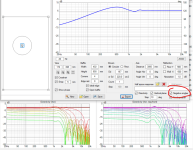
As seen nicer response is to positive angles, which means right to the speaker in VituixCAD, so opposing side of the close edge as per the quote.
Implication is, that if toe-in is small, on axis crossing behind listener, direct sound is likely better if tweeters are outside in a stereo setup like so:
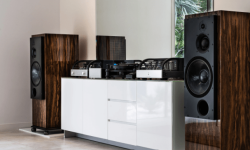
And if the speaker is toed in heavily to cross in front of listener, then put tweeters inside. Asymmetry means early side reflections have different spectra than direct sound on the diffracting bandwidth, which is roughly from baffle width wavelength to transducer diameter wavelength in this case. Also it would matter which way speaker are setup, tweeter in or outside. This would be the listening test on the quote.
Another implication of strong edge diffraction interference, if one wants perception of very sharp phantom image, it is absolutely necessary to have symmetric toe-in for speakers to have direct sound as similar as possible on both sides. Also symmetric setup in room or heavy attenuation / long delay on early rerflections otherwise those differ on both sides because frequency response varies per angle, incident angle of early specular reflections must match left right. Otherwise the sides differ and phantom isn't as solid as it could. If listening distance is far it's always hazy so no stress in that case.
Last edited:
I feel like this thread has solidified my thinking...which is that my thinking should stay liquid. So in that spirit I'm working on my own pap style modular frame that will continue to allow me to try different approaches. I will try to design it such that it can support nude drivers and baffles.
My first baffles on it will be a nude mid successively larger baffles for the midbass and subwoofer.
I will report back on my progress and build notes.
My first baffles on it will be a nude mid successively larger baffles for the midbass and subwoofer.
I will report back on my progress and build notes.
Haven't got it all hooked up yet but I'll report back once I've had some time with it.
I happened to have a sheet of scrap wood that was 36" wide so I thought I would try a mostly baffleless midrange.
For me, personally, I'm not super picky about really deep bass so it's possible that the 18+12 with no baffle and some eq will do, for me personally.
Certainly curious what 6"W full range with no baffle sounds like in the 4k + range.
I happened to have a sheet of scrap wood that was 36" wide so I thought I would try a mostly baffleless midrange.
For me, personally, I'm not super picky about really deep bass so it's possible that the 18+12 with no baffle and some eq will do, for me personally.
Certainly curious what 6"W full range with no baffle sounds like in the 4k + range.
My intention is about 80 or 100 to the 12", then about 500. I think I like these wide range drivers crossed to a rear or up firing super tweeter at 8000 but need to keep playing with that.
I tried a 12 inch full range with no baffle, 1 meter baffle, 2.5 meter baffle, with driver 20 cm from the floor and centered on x axis. I can just say that the 2.5 meter sounded best...I would like to try 4 meters but...well...
The baffle wasn't straight, it had an angle of 80 degrees.
The baffle wasn't straight, it had an angle of 80 degrees.
Just speaker to the amp, no filter. I tried band pass filter for fullrange, but was not happy with the result. I am not saying this is right, but for me fullrange goes hand in hand with single ended, no filter, open baffle or big boxes. But i don't want to deviate the topic from open baffle here.
I hope one day i can listen to this Wharfedale SFB/3 if anyone heard one of those.

I hope one day i can listen to this Wharfedale SFB/3 if anyone heard one of those.
Have you ever thought that baffle dimensions might have some effect to response? 15dB at 100Hz!

what´s the planar midrange you are using?Sounds like a plan.
In my 4way ob I use 150Hz for the ob subs, active biamping. Betsy to planar is 900Hz, was lower, but planar did not like it. 7kHz to top super tweeter.
Last edited:
Yes of course. I don't know the gap between reality and simulation ? I ask this because i have worked with people doing heat simulation for laptops for the product design, and every time they released the design, it fails in reality and we would need to increase the cooling because the laptop would overheat otherwise. I am not critisizing simulation for audio, as i am not qualified to judge it, i am just asking ?Have you ever thought that baffle dimensions might have some effect to response? 15dB at 100Hz!
View attachment 1316751
The gap is minimal in anechoic space, that has been proven hundreds of times here with various projects. By measurements basically, but gross differences are easily heard.
In-room and speaker near the floor or walls will always have remarkable effect which are more difficult to predict in total. My point was that you were telling about bass sound where the dipole loss effect is largest with typical realistic indoor speakers.
I am as well puzzled when people say specific drivers sound this and that, without any eq or crossovers. Of course they do, that's why science has helped to develop multiway speakers where nasties of single drivers e.g. resonances, directivity mismatch and high distortion can be mitigated.
In-room and speaker near the floor or walls will always have remarkable effect which are more difficult to predict in total. My point was that you were telling about bass sound where the dipole loss effect is largest with typical realistic indoor speakers.
I am as well puzzled when people say specific drivers sound this and that, without any eq or crossovers. Of course they do, that's why science has helped to develop multiway speakers where nasties of single drivers e.g. resonances, directivity mismatch and high distortion can be mitigated.
- Home
- Loudspeakers
- Multi-Way
- OB baffle design options

